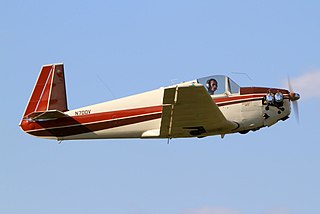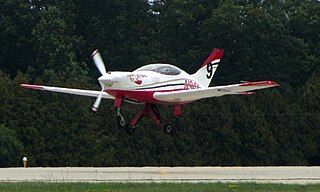
The Arnold AR-5 is an experimental single seat, low-wing sport monoplane with fixed conventional undercarriage, designed and built by Mike Arnold.

The Arnold AR-5 is an experimental single seat, low-wing sport monoplane with fixed conventional undercarriage, designed and built by Mike Arnold.
Originally conceived by Mike Arnold as a personal sport airplane with excellent performance and good handling qualities. The design outperformed initial performance estimates for its relatively low power output, exceeding 200mph with only 65hp. [1] Constructed of fiberglass-epoxy matrix composite material utilizing the "moldless method" popularized by Burt Rutan. [2] Careful attention to aerodynamic detail resulted in noteworthy laminar flow drag reduction, as documented by aerodynamicists Alex Strojnik and Bruce Carmichael.[ citation needed ]
In 1992, the AR-5 flown by Mike Arnold set the FAI C1a Class World Speed Record of 343,08 km/h over a 3.0km course. [3] Mike wrote several articles about his design methodology for various magazines. [4] [5] The sole existing example resides at the Hiller Aviation Museum, San Carlos, CA. [6]
General characteristics
Performance

Elbert Leander "Burt" Rutan is a retired American aerospace engineer and entrepreneur noted for his originality in designing light, strong, unusual-looking, and energy-efficient air and space craft. He designed the record-breaking Voyager, which in 1986 was the first plane to fly around the world without stopping or refueling, and the Virgin Atlantic GlobalFlyer, which in 2006 set the world record for the fastest and longest nonstop non-refueled circumnavigation flight in history. In 2004, Rutan's sub-orbital spaceplane design SpaceShipOne became the first privately funded spacecraft to enter the realm of space, winning the Ansari X-Prize that year for achieving the feat twice within a two-week period.

The Scaled Composites Model 311 Virgin Atlantic GlobalFlyer is an aircraft designed by Burt Rutan in which Steve Fossett first flew a solo nonstop airplane flight around the world in slightly more than 67 hours. The flight speed of 342 miles per hour (550 km/h) set the world record for the fastest nonstop non-refueled circumnavigation, beating the mark set by the previous Rutan-designed Voyager aircraft at 9 days 3 minutes and a top speed of 116 miles per hour (187 km/h).

The Rutan VariEze is a composite, canard aircraft designed by Burt Rutan. It is a high-performance homebuilt aircraft, hundreds of which have been constructed. The design later evolved into the Long-EZ and other, larger cabin canard aircraft. The VariEze is notable for popularizing the canard configuration and moldless glass cloth composite construction for homebuilt aircraft.

The Beechcraft Model 76 Duchess is an American twin-engined monoplane built by Beechcraft intended partly as a low cost introduction to twin-engine aircraft.

The Mooney M-18 "Mite" is a low-wing, single-place monoplane with retractable, tricycle landing gear.

The Sonerai is a small, VW-powered homebuilt aircraft, designed by John Monnett. The Sonerai began to compete as a single-seat, mid-wing, tailwheel Formula-V racer class formed in 1972. The Sonerai soon evolved into a two-seat model called the Sonerai II.
The Eagle AC-7 Eagle 1 is an aircraft that was manufactured by Windecker Industries. It was the first composite airplane to receive FAA certification in December 1969 at a reported development cost of US$20,000,000. The fiberglass process was named "Fibaloy" by Windecker.

The Scaled Composites Model 81 Catbird is a high-efficiency five-seat single-engine all-composite general aviation aircraft designed by Burt Rutan. It is unusual in that it incorporates both a small forward wing and a small conventional horizontal stabilizer on the tail.

The Questair Venture is a homebuilt aircraft manufactured by Questair at John Bell Williams Airport in Bolton, Mississippi, United States. The aircraft first flew on 1 July 1987.

The Murphy JDM-8 is a Canadian single-seat ultralight monoplane designed by Daryl Murphy. The type was intended to be sold as a kit for home construction by Murphy Aircraft of Chilliwack, British Columbia.
The Rans S-16 Shekari is an American single-engined, two-seat, low-wing, aerobatic monoplane designed by Randy Schlitter, built by Rans Inc and sold as a kit for amateur construction.

The N.V. Vliegtuigbouw 013 Sagitta is a Dutch mid-wing, single-seat Standard Class glider designed by Piet Alsema and produced by N.V. Vliegtuigbouw.

The Politechnika Warszawska PW-2, also called the PW-2 Gapa, is a Polish lightweight high-wing, strut-braced single-seat, glider that was designed and built at the Warsaw University of Technology and also produced by DWLKK in the early 1990s. Total number of 19 gliders were built, including variant PW-2D bis.
The Danieli Piuma is a family of Italian high-wing, strut-braced, pusher configuration single-seat motor gliders that was designed by Tiziano Danieli of Schio and supplied as plans for amateur construction.

The Partenair Mystere is a Canadian two-seat, pusher configuration monoplane that was designed by Partenair Design of Saint-Jean-sur-Richelieu, Quebec and intended for amateur construction from kits.
The Dempsey TD-3 Beta Lightning is the second original homebuilt aeroplane design by Thomas Dempsey.

The Pro-Composites Personal Cruiser, also called the Corvair Cruiser, is a single seat, composite homebuilt aircraft.

The Team Tango Foxtrot, or Foxtrot 4, is an American amateur-built aircraft, designed and produced by Team Tango of Williston, Florida. The aircraft is supplied as a kit for amateur construction, with or without factory builder assistance.

The Viking SF-2A Cygnet, also called the Sisler SF-2A Cygnet and the HAPI SF-2A Cygnet, is an American STOL amateur-built aircraft, designed by Bert Sisler and produced by Viking Aircraft LLC. The aircraft is supplied in the form of plans for amateur construction. The Cygnet first flew in 1973.
The Arnold AR-6 is a single seat low wing monoplane racing aircraft.